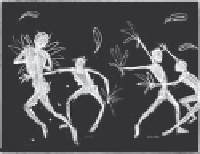Graphics Reference
In-Depth Information
unavoidable fact that a creature just a few inches tall will behave and move very dif erently
from a thirty-foot-high beast; this is a surprise to most beginners. First, you need to look at
your puppet and ask yourself just how tall it is meant to be in the imagined world. For all its
sublime and spirited animation, the original King Kong does sometimes betray its eighteen-
inch height. Giving the sense of scale and weight can be helped enormously by the camera
work: if a character is perceived to be unnaturally tall next to the 'normal' protagonists, as in
the case of a rampaging dinosaur, the camera is usually looking up at it for most of the time,
from our characters' point of view. Conversely, a camera usually looks down on characters
regarded as small. Even so, the camera work alone is not likely to help create the illusion of
mass and weight in a huge creature. This has to come from the animation and acting. If you
look at some of the shots of Kong swiping at passers-by, some of the gestures take perhaps
a mere half a dozen frames to move from his chest to a more outstretched gesture. With a
puppet just eighteen inches high, moving an arm through the real six-inch spatial radius of its
arm in six frames seems entirely credible. But transpose that to the twenty-i ve or thirty feet
that Kong was meant to be, and the same gesture has an arm supposedly travelling through
a space of perhaps twelve to i fteen feet in six frames. By any physiological standards it would
be pretty impossible for muscles and a skeleton to work like that. The bigger a character it
is, not only do their limbs have further to travel, but also they are going to be heavier, with
a bulkier skeleton needed to support that. This is another mistake often made about scale,
that an unnaturally large-scaled character is just a matter of blowing up the proportions.
Most characters we animate need to obey some laws of physics and anatomy, and generally
the bigger something is the more mass it is going to need to support it. This not only leads
to necessary design decisions, but also decisions about how such a character will move. A
huge, thirty-foot character might lose some credibility if it were to skip about like a two-foot-
high newborn lamb. You need to i nd a movement that suggests its bulk and weight, and this
usually necessitates moving a character far more slowly.
In the early days of special ef ects, when real lizards and komodo dragons were used to suggest
dinosaurs, they were i lmed from a very low angle with a distorting lens, and always a high speed,
so when the i lm was run normally the dragon appeared to be moving so much more slowly.
I don't think I was ever convinced by these special ef ects, as there was always some quality to the
movement (as there was always some movement in rotoscoping that betrays its origins) that gave
away just how big or small these animals were in real life. Probably something about the way the
skin wobbled, or the way the tongue darted, or maybe just how anatomically unconvincing the
texture of the skin looked when blown up to such proportions. I was always thinking there should
be more scales on a creature that size. The inevitable stuck-on i ns or stegosaurus plates totally
gave the game away. But it was dei nitely the movement that I saw through, especially when
two lizards were i ghting. Their reactions were just too speedy and they lifted of the ground for
too long and too easily. There is no getting away from the fact that a bigger creature will be built
dif erently and move dif erently from a small creature, whatever the environment.
Talos
Harryhausen's animation of Talos in
Jason and the Argonauts
is a great example of
mass. Looking about sixty feet high, Talos is moved slowly, with movements that
do not stop in a couple of frames, but have a long, slow follow-through, suggesting
an enormous inertia. There are no quick movements as they would destroy the


Search WWH ::

Custom Search